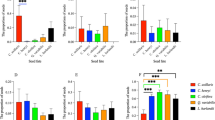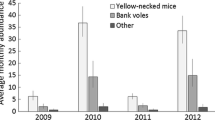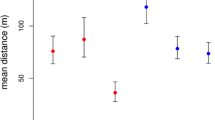Abstract
Understanding rodent seed caching behavior is critical for effective forest management and conservation. While it is well established that rodent feeding behavior is strongly affected by seed traits and insect infestation of seeds, there is still a knowledge gap on how these factors affect rodent feeding behavior. Here we conducted a series of experiments to investigate the feeding and hoarding preferences of two sympatric rodent species, the Chinese white-bellied rat (Niviventer confucianus) and South China field mouse (Apodemus draco) in response to Chinese chestnuts (Castanea mollissima) of contrasting seed size and insect infestation. When only sound nuts (not infested nuts) were provided, both species preferentially consumed larger nuts, esp. the larger N. confucianus showed more pronounced selective preference for larger nuts than the smaller A. draco. When sound and insect-infested nuts of equal size were provided, neither species selected for sound over insect-infested nuts, but infested seeds were more frequently consumed in situ. If nuts of differing size and infestation status were provided, rodents preferred to eat and hoard larger seeds regardless of insect infestation. Overall, however, infested seeds were more often consumed immediately in situ while sound seeds were more often consumed ex situ or cached. Our results thus support the seed size hypothesis, but show little evidence for the insect infestation hypothesis, and highlight that food preferences and optimal foraging decisions differ between sympatric rodent species.
Significance statement
Rodent caching and feeding behaviors are strongly affected by co-varying seed traits such as size and insect infestation, which in turn regulate seed survival and seedling recruitment. By using semi-natural enclosures, we detected differences in feeding and hoarding behaviors between sympatric rodent species, and their different preferences for seed size and insect infestation. These different preferences may support the seed size hypothesis. Rodents based their foraging decision predominantly on seed size and not insect infestation, preferring to eat and hoard larger seeds regardless of their insect infestation. We suggest that the differences in feeding and hoarding behaviors of sympatric rodent species in relation to seed size and insect infestation should be considered in future field studies, as this will help us to better understand mechanisms that impact forest management and conservation.

Similar content being viewed by others
Data availability
The datasets and codes used in this study are presented in the Supplementary Information.
References
Bogdziewicz M, Espelta JM, Muoz A, AparicioJM BR (2018) Effectiveness of predator satiation in masting oaks is negatively affected by conspecific density. Oecologia 186:983–993. https://doi.org/10.1007/s00442-018-4069-7
Bozinovic F (1992) Rate of basal metabolism of grazing rodents from different habitats. J Mammal 73:379–384. https://doi.org/10.2307/1382072
Butet A, Delettre YR (2011) Diet differentiation between European arvicoline and murine rodents. Acta Theriol 56:297–304. https://doi.org/10.1007/s13364-011-0049-6
Cao L, Yan C, Wang B (2018) Differential seed mass selection on hoarding decisions among three sympatric rodents. Behav Ecol Sociobiol 72:161. https://doi.org/10.1007/s00265-018-2576-5
Capellini I, Venditti C, Barton RA (2010) Phylogeny and metabolic scaling in mammals. Ecology 91:2783–2793. https://doi.org/10.1890/09-0817.1
Chang G, Xiao ZS, Zhang ZB (2009) Hoarding decisions by Edward’s long-tailed rats (Leopoldamys edwardsi) and South China field mice (Apodemus draco): The responses to seed size and germination schedule in acorns. Behav Process 82:7–11. https://doi.org/10.1016/j.beproc.2009.03.002
Chang G, Zhang ZB (2014) Functional traits determine formation of mutualism and predation interactions in seed-rodent dispersal system of a subtropical forest. Acta Oecol 55:43–50. https://doi.org/10.1016/j.actao.2013.11.004
Charles LS, Dwyer JM, Chapman HM, Yadok BG, Mayfield MM (2019) Landscape structure mediates zoochorous-dispersed seed rain under isolated pasture trees across distinct tropical regions. Landscape Ecol 34:1347–1362. https://doi.org/10.1007/s10980-019-00846-3
Chen WW, Zhang Z, Buesching CD, Newman C, Macdonald DW, Xie ZQ, Sun SC, Zhou YB (2017) Discrimination behavior mediates foraging quality versus quantity trade-offs: nut choice in wild rodents. Behav Ecol 28:607–616. https://doi.org/10.1093/beheco/arw180
Cui JF, Chen WW, Newman C, Han WW, Buesching CD, Macdonald DW, Xie ZQ, Zhou YB (2018) Roads disrupt rodent scatter-hoarding seed-dispersal services: implication for forest regeneration. Perspect Plant Ecol 34:102–108. https://doi.org/10.1016/j.ppees.2018.08.006
Deng YH, Ju MY, Yi XF (2020) Exclusion of interspecific competition reduces scatter-hoarding of Siberian chipmunk Tamias sibiricus: a field study. Integr Zool 15:127–134. https://doi.org/10.1111/1749-4877.12416
Dimitri LA, Longland WS, Vander Wall SB (2017) Cone and seed traits of two juniperus species influence roles of frugivores and scatter-hoarding rodents as seed dispersal agents. Acta Oecol 85:93–103. https://doi.org/10.1016/j.actao.2017.09.012
Gliwicz J, Taylor JR (2002) Comparing life histories of shrews and rodents. Acta Theriol 47:185–208. https://doi.org/10.1007/BF03192487
Hadj-Chikh LZ, Steele MA, Smallwood PD (1996) Caching decisions by grey squirrels: a test of the handling time and perishability hypotheses. Anim Behav 52:941–948. https://doi.org/10.1006/anbe.1996.0242
Hou X, Zhang B, Chen XN, Wang J, Han N, Chang G (2016) Seed-hoarding behaviours of three sympatric rodent species on two tree species under semi-natural enclosure conditions. Acta Theriol 36:207–214. https://doi.org/10.16829/j.slxb.201602009
Hou X, Zhang B, Han N, Feng T, Wang J, Chen XN, Chang G (2020) Differences in feeding and hoarding behaviors between intact and weevil-infested seeds of Quercus aliena var. acuteserrata by Apodemus draco and Niviventer confucianus under enclosure conditions. Acta Theriol 40:390–397. https://doi.org/10.16829/j.slxb.150331
Hou X, Zhang B, Steele MA, Han N, Feng T, Wang J, Chen XN, An XL, Chang G (2021) Seed traits and rodent community interact to determine seed fate: evidence from both enclosure and field experiments. Integr Zool 16:939–954. https://doi.org/10.1111/1749-4877.12596
Jacobs LF (1992) The effect of handling time on the decision to cache by grey squirrels. Anim Behav 43:522–524. https://doi.org/10.1016/s0003-3472(05)80111-3
Leishman MR (2001) Does the seed size/number trade-off model determine plant community structure? An assessment of the model mechanisms and their generality. Oikos 93:294–302. https://doi.org/10.1034/j.1600-0706.2001.930212.x
Lichti NI, Steele MA, Swihart RK (2017) Seed fate and decision-making processes in scatter-hoarding rodents. Biol Rev 92:474–504. https://doi.org/10.1111/brv.12240
MacArthur RH, Pianka ER (1966) On optimal use of a patchy environment. Am Nat 100:603–609. https://doi.org/10.1086/282454
Moles AT, Westoby M (2006) Seed size and plant strategy across the whole life cycle. Oikos 113:91–105. https://doi.org/10.1111/j.0030-1299.2006.14194.x
Moore JE, McEuen AB, Swihart RK, Contreras TA, Steele MA (2007) Determinants of seed removal distance by scatter–hoarding rodents in deciduous forests. Ecology 88:2529–2540. https://doi.org/10.1890/07-0247.1
Morán-López T, Valladares F, Tiribelli F, Pérez-Sepúlveda JE, Traveset A, Díaz M (2018) Fragmentation modifies seed trait effects on scatter-hoarders’ foraging decisions. Plant Ecol 219:325–342. https://doi.org/10.1007/s11258-018-0798-2
Muller-Landau HC (2010) The tolerance–fecundity tradeoff and the maintenance of diversity in seed size. P Natl Acad Sci USA 107:4242–4247. https://doi.org/10.1073/pnas.0911637107
Muñoz A, Bonal R (2008) Are you strong enough to carry that seed? Seed size/body size ratios influence seed choices by rodents. Anim Behav 76:709–715. https://doi.org/10.1016/j.anbehav.2008.03.017
Nagy KA (2005) Field metabolic rate and body size. J Exp Biol 208:1621–1625. https://doi.org/10.1242/jeb.01553
Niu HY, Zhang J, Wang ZY, Huang GC, Peng C, Zhang HM (2020) Context-dependent responses of food-hoarding to competitors in Apodemus peninsulae: implications for coexistence among asymmetrical species. Integr Zool 15:115–126. https://doi.org/10.1111/1749-4877.12425
Perea R, López D, San Miguel A, Gil L (2012) Incorporating insect infestation into rodent seed dispersal: better if the larva is still inside. Oecologia 170:723–733. https://doi.org/10.1007/s00442-012-2350-8
Pyke GH (2019) Optimal foraging theory: an introduction. In: Choe JC (ed) Encyclopedia of animal behavior. Elsevier Academic Press, Amsterdam, pp 111–117
R Core Team (2017) R: a language and environment for statistical computing. R Foundation for Statistical Computing, Vienna, Austria, https://www.R-project.org. Accessed 5 April 2018
Rusch UD, Midgley JJ, Anderson B (2013) Rodent consumption and caching behaviour selects for specific seed traits. S Afr J Bot 84:83–87. https://doi.org/10.1016/j.sajb.2012.09.007
Smith CC, Reichman OJ (1984) The evolution of food caching by birds and mammals. Annu Rev Ecol Syst 15:329–351. https://doi.org/10.1146/annurev.es.15.110184.001553
Semel B, Andersen DC (1988) Vulnerability of acorn weevils (Coleoptera: curculionidae) and attractiveness of weevils and infested Quercus alba acorns to Peromyscus leucopus and Blarina brevicauda. Am Midl Nat 119:385–393. https://doi.org/10.2307/2425821
Sobral M, Guitián J, Guitián P, Larrinag AR (2014) Seed predators exert selection on the subindividual variation of seed size. Plant Biol 16:836–842. https://doi.org/10.1111/plb.12118
Sone K, Oishi K, Shibato T, Hata K (2016) Effects of acorn attack by curculio weevils on the germination and early growth of Pasania edulis (Makino) seedlings. J Forestry Res 21:185–192. https://doi.org/10.1007/s10310-016-0531-8
Sundaram M, Lichti NI, Widmar NJO, Swihart RK (2017) Eastern gray squirrels are consistent shoppers of seed traits: insights from discrete choice experiments. Integr Zool 13:280–296. https://doi.org/10.1111/1749-4877.12294
Vander Wall SB (1990) Food hoarding in animals. University of Chicago Press, Chicago
Vander Wall SB (2003) Effects of seed size of wind-dispersed pines (Pinus) on secondary seed dispersal and the caching behavior of rodents. Oikos 100:25–34. https://www.jstor.org/stable/3548257. Accessed 8 May 2020
Vander Wall SB, Dimitri LA, Longland WS, White JDM (2019) Seed value influences cache pilfering rates by desert rodents. Integr Zool 14:75–86. https://doi.org/10.1111/1749-4877.12358
Wang B, Chen J (2011) Scatter-hoarding rodents prefer slightly astringent food. PLoS One 6:e26424. https://doi.org/10.1371/journal.pone.0026424
Wang B, Corlett RT (2017) Scatter-hoarding rodents select different caching habitats for seeds with different traits. Ecosphere 8:e01774. https://doi.org/10.1002/ecs2.1774
Wang B, Ye CX, Cannon CH, Chen J (2013) Dissecting the decision making process of scatter-hoarding rodents. Oikos 122:1027–1034. https://doi.org/10.1111/j.1600-0706.2012.20823.x
Wang J, Zhang B, Han N, Feng T, Hou X, An XL, Chen XN, Chang G (2021) Effects of mast seeding and insect infestation on predation and dispersal of Castanea mollissima nuts by rodents in the Qinling Mountains of China. Forest Ecol Manag 499:119630. https://doi.org/10.1016/j.foreco.2021.119630
Wang TZ, Xu WX (1993) Glires (Rodentia and Lagomorpha) fauna of Shaanxi province. Shaanxi Normal University Press, Shaanxi
Wang ZY, Wang B, Yan C, Yuan SD, Cao L (2020) Neighborhood effects on the tannin-related foraging decisions of two rodent species under semi-natural conditions. Integr Zool 15:569–577. https://doi.org/10.1111/1749-4877.12473
Weckerly FW, Nicholson KE, Semlitch RD (1989) Experimental test of discrimination by squirrels for insect-infested and non-infested acorns. Am Midl Nat 122:412–415. https://doi.org/10.2307/2425929
Xiao ZS, Gao X, Zhang ZB (2013) The combined effects of seed perishability and seed size on hoarding decisions by Pére David’s rock squirrels. Behav Ecol Sociobiol 67:1067–1075. https://doi.org/10.1007/s00265-013-1531-8
Yang YQ, Wang ZY, Yan C, Zhang YH, Zhang DY, Yi XF (2018) Selective predation on acorn weevils by seed caching Siberian chipmunk Tamias sibiricus in a tripartite interaction. Oecologia 188:149–158. https://doi.org/10.1007/s00442-018-4161-z
Yeakel JD, Bhat U, Newsome SD (2020) Caching in or falling back at the Sevilleta: the effects of body size and seasonal uncertainty on desert rodent foraging. Am Nat 196:241–256. https://doi.org/10.1086/709019
Yi XF, Steele MA, Zhang ZB (2012) Acorn pericarp removal as a cache management strategy of the Siberian chipmunk, Tamias sibiricus. Ethology 118:87–94. https://doi.org/10.1111/j.1439-0310.2011.01989.x
Yi XF, Zhang MM, Bartlow AW, Dong Z (2014) Incorporating cache management behavior into seed dispersal: the effect of pericarp removal on acorn germination. PLoS One 9:e92544. https://doi.org/10.1371/journal.pone.0092544
Yu F, Shi XX, Wang DX, Yi XF, Fan DF, Guo TD, Lou YG (2015) Effects of insect infestation on Quercus aliena var. acuteserrata acorn dispersal in the Qinling Mountains. China New Forest 46:51–61. https://doi.org/10.1007/s11056-014-9446-4
Zhang B, Chen XN, Steele MA, Li JG, Chang G (2019) Effects of insect infestation on rodent-mediated dispersal of Quercus aliena: results from field and enclosure experiments. Integr Zool 14:104–113. https://doi.org/10.1111/1749-4877.12350
Zhang HM, Chu W, Zhang ZB (2017) Cultivated walnut trees showed earlier but not final advantage over its wild relatives in competing for seed dispersers. Integr Zool 12:12–25. https://doi.org/10.1111/1749-4877.12242
Zhang HM, Gao HY, Yang Z, Wang ZZ, Luo Y, Zhang ZB (2014) Effects of interspecific competition on food hoarding and pilferage in two sympatric rodents. Behaviour 151:1579–1596. https://doi.org/10.1163/1568539X-00003201
Zhang HM, Yan C, Chang G, Zhang ZB (2016) Seed trait-mediated selection by rodents affects mutualistic interactions and seedling recruitment of co-occurring tree species. Oecologia 180:475–484. https://doi.org/10.1007/s00442-015-3490-4
Zhang ZB (2019) Studies on the rodent-seed interactions of forest ecosystems——exploring the secrets of cooperation between antagonists. Science Press, Beijing
Zwolak R, Clement D, Sih A, Schreiber SJ (2021) Mast seeding promotes evolution of scatter-hoarding. Phil Trans R Soc B 376:20200375. https://doi.org/10.1098/rstb.2020.0375
Acknowledgements
We are very grateful to Prof. Christina and Chris for their valuable comments and language editing on earlier drafts of this manuscript. We thank the Foping National Nature Reserve for support. We also thank the anonymous referees for their comments, as they greatly improved the quality of this manuscript.
Funding
This work was supported by the National Natural Science Foundation of China (32172436; 31901085), the Shaanxi Key Research and Development Program (2021NY-042), the Shaanxi Natural Science Foundation (2021JQ-841), the Science and Technology Program of Shaanxi Academy of Science (2020 K-21; 2022 K-06; 2022 K-16), the Science and Technology Innovation Program of Shaanxi Academy of Forestry (SXLK2020-0209), and the Second Tibetan Plateau Scientific Expedition and Research Program (STEP, 2019QZKK0501).
Author information
Authors and Affiliations
Contributions
XLA and XH conceived the ideas. XLA, XH, and GC designed the experiments. BZ, TF, NH, JW, XNC, and MQ collected the data; XLA, JDZ, and XH analyzed the data; and XLA, XH, JW, and XNC led the writing of the manuscript. All authors contributed to drafts and gave final approval for publication.
Corresponding author
Ethics declarations
Ethics approval
In this study, animal trapping, feeding experiments, and housing conditions adhered to the ASAB/ABS Guidelines for the Use of Animals in Research. The whole research process was approved by the Institutional Animal Care and Use Committee of Shaanxi Institute of Zoology (SIZ-IACUC-Protocol No. 18–15). No animals died in the experiments, and all experimental individuals were released at the original sites of capture following a health inspection by a veterinarian once the experiments were finished.
Conflict of interest
The authors declare no competing interests.
Additional information
Communicated by A. G Ophir
Publisher's note
Springer Nature remains neutral with regard to jurisdictional claims in published maps and institutional affiliations.
Supplementary Information
Below is the link to the electronic supplementary material.
Rights and permissions
Springer Nature or its licensor holds exclusive rights to this article under a publishing agreement with the author(s) or other rightsholder(s); author self-archiving of the accepted manuscript version of this article is solely governed by the terms of such publishing agreement and applicable law.
About this article
Cite this article
An, XL., Zhang, B., Feng, T. et al. Chestnut caching behavior of Chinese white-bellied rats (Niviventer confucianus) and South China field mice (Apodemus draco): effects of seed size and insect infestation. Behav Ecol Sociobiol 76, 140 (2022). https://doi.org/10.1007/s00265-022-03247-w
Received:
Revised:
Accepted:
Published:
DOI: https://doi.org/10.1007/s00265-022-03247-w




